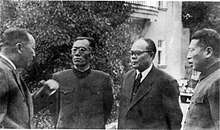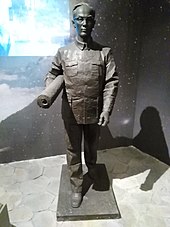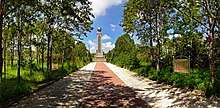Two Bombs, One Satellite
Two Bombs, One Satellite (Chinese: 两弹一星; pinyin: Liǎngdàn Yīxīng) was an early nuclear and space project of the People's Republic of China. Two Bombs refers to the atomic bomb (and later the hydrogen bomb) and the intercontinental ballistic missile (ICBM), while One Satellite refers to the artificial satellite. China tested its first atomic bomb and first hydrogen bomb in 1964 and 1967 respectively, combining the atomic bomb with surface-to-surface missile in 1966, and successfully launched its first satellite (Dong Fang Hong I) in 1970.[1][2]
| History of the People's Republic of China (PRC) |
|---|
.svg.png) |
|
Hu and the fourth generation |
| History of |
| Generations of leadership |
|
|
History
Proposal and Soviet aid

In the 1940s and 1950s, a group of leading scientists including Qian Xuesen, Deng Jiaxian and Qian Sanqiang returned to mainland China from abroad.[3][4][5]
In January 1955, Mao Zedong expressed the intention of developing atomic bombs during a meeting of the Secretariat of the Communist Party of China.[6]
In 1956, hundreds of experts were called by Zhou Enlai, Chen Yi, Li Fuchun and Nie Rongzhen to make plans for China's scientific development, eventually creating an outline of development for the period from 1956 to 1967 (1956-1967年科学技术发展远景规划纲要).[7]
In 1958, Mao formally announced the development of nuclear bombs, missiles and satellite.[6] At the same time, the Soviet Union had provided China with important assistance since 1955, even though on December 10, 1957, the Soviet Union proposed that the United States, the United Kingdom, and the USSR halt nuclear weapons tests for the next two to three years, to which China supported.[8][9][10]
Great Leap Forward and Cultural Revolution

Since 1958, the researches on "Two Bombs, One Satellite" were negatively impacted by the Anti-Rightist Campaign and the Great Leap Forward, which caused the deaths of tens of millions in the Great Chinese Famine.[9] In addition, since the Sino-Soviet split in late 1950s, the Soviet Union gradually ended its assistance to China and recalled all of its experts - although in 1958, China had created its first experimental nuclear pile with the help of the Soviet Union.[6][9][10][11][12]
In 1961–62, there was a disagreement among senior officials of the Communist Party of China as well as the Chinese government on whether China should continue with the "Two Bombs, One Satellite" project.[13] Eventually, in November 1962, a central committee led by Zhou Enlai, Nie Rongzhen and others was established, and the project was carried on.[11][13]
In 1966, Mao launched the Cultural Revolution. Academics and intellectuals were regarded as "Stinking Old Ninth" and were widely persecuted.[11] In 1968, among the leading scientists who worked on the "Two Bombs, One Satellite" program, Yao Tongbin was beaten to death and Zhao Jiuzhang committed suicide,[14][15] while Guo Yonghuai was killed in a plane crash.[16] As of September 1971, more than 4,000 staff members of China's nuclear center in Qinghai were persecuted; more than 310 of them were permanently disabled, over 40 people committed suicide, and five were executed.[17] Many researchers with overseas education background (especially from the United States and the United Kingdom) were regarded as "spies".[18] Only a few scientists including Qian Xuesen were protected in the Revolution because of a special list made by Premier Zhou Enlai (approved by Mao) in August 1966.[11]

Timeline of milestones
- On October 16, 1964, China's first atomic bomb was successfully detonated in Lop Nur (code-name "Project 596"), making China the fifth country in the world to possess nuclear weapons.[9]
- On October 27, 1966, China's first surface-to-surface missile (Dongfeng-2) carrying nuclear bomb was successfully launched and detonated.[9][19]
- On June 17, 1967, China's first hydrogen bomb was successfully detonated in Lop Nur (code-name "Test No. 6").[9][20]
- On April 24, 1970, China's first satellite (Dong Fang Hong I) was successfully launched into space, making China the fifth nation to put a spacecraft into orbit using its own rocket.[21]
Aftermath and memorial
After the Cultural Revolution, Deng Xiaoping became the new paramount leader of China and started the "Boluan Fanzheng" program. Scientists and intellectuals were rehabilitated and, in particular, Yao Tongbin was honored as a "martyr".[22] Deng emphasized that knowledge and talented people must be respected, and the wrong thought of disrespecting intellectuals must be opposed.[23]
In 1986, four leading scientists who had worked on the "Two Bombs, One Satellite" program proposed to Deng that China must stimulate the development of advanced technologies. Upon Deng's approval, the "863 Program" was launched.[24]
In 1999, twenty-three scientists who had made significant contributions in the "Two Bombs, One Satellite" program were awarded the Two Bombs and One Satellite Merit Award (Chinese: 两弹一星功勋奖章).[25][26] In 2015, the "Two Bombs, One Satellite Memorial Museum" was opened on the Huairou campus of the University of the Chinese Academy of Sciences.[27]
| Awardee | Field | Contribution | Alma mater |
|---|---|---|---|
| Chen Fangyun (1916–2000) | Radio electronics | Satellite | National Southwestern Associated University |
| Chen Nengkuan (1923–2016) | Metal physics Detonation physics |
Atomic bomb and hydrogen bomb | National Tangshan Engineering College Yale University |
| Cheng Kaijia (1918–2018) | Nuclear physics | Atomic bomb and hydrogen bomb | Zhejiang University University of Edinburgh |
| Deng Jiaxian (1924–1986) | Nuclear physics | Atomic bomb and hydrogen bomb | National Southwestern Associated University Purdue University |
| Guo Yonghuai (1909–1968) | Aerodynamics | Atomic bomb, hydrogen bomb and missile | Peking University University of Toronto California Institute of Technology |
| Huang Weilu (1916–2011) | Engineering cybernetics | Missile | National Central University Imperial College London |
| Peng Huanwu (1915–2007) | Theoretical physics | Atomic bomb and hydrogen bomb | Tsinghua University University of Edinburgh |
| Qian Ji (1917–1983) | Space physics | Satellite | National Central University |
| Qian Sanqiang (1913–1992) | Nuclear physics | Atomic bomb and hydrogen bomb | Tsinghua University University of Paris Collège de France |
| Qian Xuesen (1911–2009) | Aeronautics Engineering cybernetics |
Rocket, missile and satellite | National Chiao Tung University Massachusetts Institute of Technology California Institute of Technology |
| Ren Xinmin (1915–2017) | Aeronautics | Rocket, missile and satellite | National Central University Chongqing Ordnance School affiliated to Military Ministry University of Michigan |
| Sun Jiadong (1929–) | Aeronautics | Missile and satellite | Harbin Institute of Technology Zhukovsky Air Force Academy |
| Tu Shou'e (1917–2012) | Aeronautics | Missile and rocket | National Southwestern Associated University Massachusetts Institute of Technology |
| Wang Daheng (1915–2011) | Optics | Atomic bomb and satellite | Tsinghua University Imperial College London |
| Wang Ganchang (1907–1998) | Nuclear physics | Atomic bomb and hydrogen bomb | Tsinghua University University of Berlin |
| Wang Xiji (1921–) | Space technology | Rocket and satellite | National Southwestern Associated University Virginia Polytechnic Institute and State University |
| Wu Ziliang (1917–2008) | Chemical metallurgy | Atomic bomb | National Northwestern Engineering Institute Carnegie Institute of Technology |
| Yang Jiachi (1919–2006) | Automation | Satellite | National Chiao Tung University Harvard University |
| Yao Tongbin (1922–1968) | Aerospace materials and technology | Missile and rocket | National Tangshan Engineering College University of Birmingham |
| Yu Min (1926–2019) | Nuclear physics | Hydrogen bomb | Peking University |
| Zhao Jiuzhang (1907–1968) | Meteorology Geophysics |
Satellite | Tsinghua University University of Berlin |
| Zhou Guangzhao (1929–) | Theoretical physics | Atomic bomb and hydrogen bomb | Tsinghua University Peking University |
| Zhu Guangya (1924–2011) | Nuclear physics | Atomic bomb and hydrogen bomb | National Southwestern Associated University University of Michigan |
See also
References
- "China in Space: Carrying Forward the Spirit of Two Bombs and One Satellite". Archived from the original on 1 May 2016. Retrieved 31 May 2016.
- "China builds "two bombs, one satellite" memorial museum". Archived from the original on 14 October 2015. Retrieved 31 May 2016.
- Hvistendahl, Mara (2018-03-14). "A revered rocket scientist set in motion China's mass surveillance of its citizens". Science | AAAS. Retrieved 2020-07-15.
- "Deng Jiaxian -- china.org.cn". www.china.org.cn. Retrieved 2020-07-15.
- "Qian Sanqiang". Atomic Heritage Foundation. Retrieved 2020-07-15.
- "毛泽东与两弹一星--党史频道-人民网". dangshi.people.com.cn. Retrieved 2020-07-14.
- "我国制定《1956-1967年科学技术发展远景规划》". Ministry of Science and Technology of the People's Republic of China. Retrieved 2020-07-14.
- "Sino-Soviet Nuclear Relations: An Alliance of Convenience? | Wilson Center". www.wilsoncenter.org. Retrieved 2020-07-15.
- "Chinese Nuclear Program". Atomic Heritage Foundation. Retrieved 2020-07-14.
- "周恩来与"两弹一星"人才建设". Yanhuang Chunqiu. Retrieved 2020-07-14.
- "周恩来与中央专门委员会--周恩来纪念网--人民网". zhouenlai.people.cn. Retrieved 2020-07-14.
- "China's 'Manhattan Project'; Or, How Mao Learned to Love—and Build—the Bomb". The New York Times. Retrieved 2020-07-14.
- Song, Chundan. "1962:在两弹一星的"至暗"时刻". news.inewsweek.cn. Retrieved 2020-07-14.
- ""两弹一星"元勋姚桐斌". Chinese University of Hong Kong. Retrieved 2020-07-14.
- "Centennial held in Beijing in memory of ZHAO Jiuzhang----Chinese Academy of Sciences". english.cas.cn. Retrieved 2020-07-14.
- Chen, Ziyan. "Two asteroids named after well-known Chinese scholar couple - Chinadaily.com.cn". www.chinadaily.com.cn. Retrieved 2020-07-14.
- Wang, Jingheng. "青海核武基地的劫难". Yanhuang Chunqiu. Retrieved 2020-07-14.
- "王大珩:邓小平口中的"扫厕所专家"-搜狐新闻". news.sohu.com. Retrieved 2020-07-14.
- "1966: China launches its first nuclear missile - China.org.cn". www.china.org.cn. Retrieved 2020-07-14.
- Peng, Jichao. "中国第一颗氢弹的研发与爆炸". Yanhuang Chunqiu. Retrieved 2020-07-14.
- "NASA - NSSDCA - Spacecraft - Details". nssdc.gsfc.nasa.gov. Retrieved 2020-07-14.
- "记"两弹一星"元勋姚桐斌:助推中国火箭上天_军事_中国网_权威防务资讯". military.china.com.cn. Retrieved 2020-07-14.
- "邓小平: 尊重知识, 尊重人才". cpc.people.com.cn. Retrieved 2020-07-14.
- "National High-tech R&D Program (863 Program)". newyork.china-consulate.org. Retrieved 2020-07-14.
- "1964: "Two bombs and one satellite" launch successfully". Archived from the original on 30 June 2016. Retrieved 31 May 2016.
- "两弹一星". Archived from the original on 30 January 2019. Retrieved 31 May 2016.
- "China builds "two bombs, one satellite" memorial museum". China Military Online. 2015-09-03. Archived from the original on 2018-01-13. Retrieved 2019-02-06.
Further reading
- Chinese Nuclear Program. Atomic Heritage Foundation. July 19, 2018.
- Qian Xuesen. Atomic Heritage Foundation.
- Qian Sanqiang. Atomic Heritage Foundation.
- Deng Jiaxian. China.org.cn.
- Yu Min: The father of China’s hydrogen bomb. Peking University. September 29, 2019.